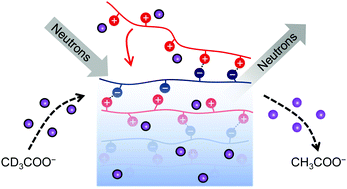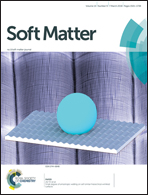Ion distribution in dry polyelectrolyte multilayers: a neutron reflectometry study†
Abstract
Ultrathin films of complexed polycation poly(diallyldimethylammonium), PDADMA, and polyanion poly(styrenesulfonate), PSS, were prepared on silicon wafers using the layer-by-layer adsorption technique. When terminated with PDADMA, all films had excess PDADMA, which was balanced by counterions. Neutron reflectivity of these as-made multilayers was compared with measurements on multilayers which had been further processed to ensure 1 : 1 stoichiometry of PDADMA and PSS. The compositions of all films, including polymers and counterions, were determined experimentally rather than by fitting, reducing the number of fit parameters required to model the reflectivity. For each sample, acetate, either protiated, CH3COO−, or deuterated, CD3COO−, served as the counterion. All films were maintained dry under vacuum. Scattering length density profiles were constrained to fit reflectivity data from samples having either counterion. The best fits were obtained with uniform counterion concentrations, even for stoichiometric samples that had been exposed to PDADMA for ca. 5 minutes, showing that surprisingly fast and complete transport of excess cationic charge occurs throughout the multilayer during its construction.



 Please wait while we load your content...
Please wait while we load your content...